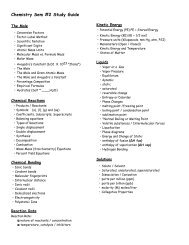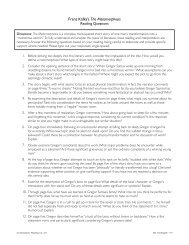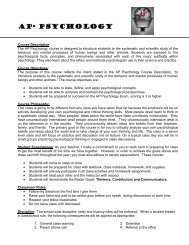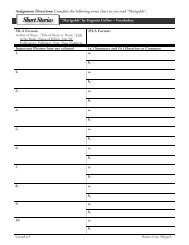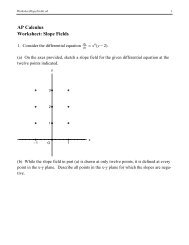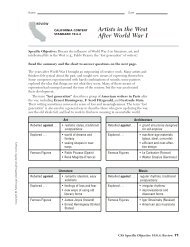British Population Moves to the Cities - Rowland High School
British Population Moves to the Cities - Rowland High School
British Population Moves to the Cities - Rowland High School
You also want an ePaper? Increase the reach of your titles
YUMPU automatically turns print PDFs into web optimized ePapers that Google loves.
NameDateCHAPTER9Section 2GEOGRAPHY APPLICATION: MOVEMENT<strong>British</strong> <strong>Population</strong> <strong>Moves</strong> <strong>to</strong> <strong>the</strong> <strong>Cities</strong>Directions: Read <strong>the</strong> paragraphs below and study <strong>the</strong> maps and graph carefully.Then answer <strong>the</strong> questions that follow.Britain’s richest coal fields are in <strong>the</strong> central andnor<strong>the</strong>rn regions of <strong>the</strong> country. This geographicfact caused a major shift in Britain’s populationbetween 1750 and 1850.Coal was found <strong>to</strong> be <strong>the</strong> most efficient way <strong>to</strong>power <strong>the</strong> new steam engine. As a result, manynew industries and fac<strong>to</strong>ries moved <strong>to</strong> be near <strong>the</strong>sources of energy. Soon, coal-fired steam enginespowered <strong>the</strong> iron foundries, textile fac<strong>to</strong>ries, andrailroads of nor<strong>the</strong>rn Britain.Industrialization also required a large laborforce. The enclosure movement, in which wealthylandowners bought out small farms and forced<strong>the</strong>se people out of <strong>the</strong>ir livelihood, provided aready supply of workers. As a result, masses of peoplemoved <strong>to</strong> <strong>the</strong> industrial cities <strong>to</strong> find jobs.Britain (mid 1700s)yNorthSCOTLAND550SeaNewcastle525500ENGLANDIrish SeaLeeds475Manchester yyyLiverpoolySheffieldfield450NottinghamNorwich425WALESBirmingham400Areas ofBris<strong>to</strong>lLondonpopulation375yconcentratione r nSe vR.Tnreeam h Tts.RR .Growth of <strong>British</strong> <strong>Cities</strong> 1760–188117601881©McDougal Littell Inc. All rights reserved. yyy350Plymouth0 100 Miles3250 200 Kilometers300275Britain (late 1800s)250yNorth225SCOTLANDSea200Newcastle175ENGLAND150Irish SeaLeedsManchesterLiverpool yySheffieldfield125NottinghamNorwich100WALESBirmingham75Areas of highBris<strong>to</strong>lLondonpopulation50 ygrowthSe vR.E n g l i se r nTram eh Th C hnets.RR .a nn elThousands of people25 yyPlymouth0 100 Miles00 200 KilometersE n g l i sh C ha nn elLiverpool Birmingham Sheffield Bris<strong>to</strong>l NottinghamThe Industrial Revolution 7
Name<strong>British</strong> <strong>Population</strong> <strong>Moves</strong> <strong>to</strong> <strong>the</strong> <strong>Cities</strong> continuedInterpreting Text and Visuals1. Of <strong>the</strong> cities shown on <strong>the</strong> bar graph, which one had <strong>the</strong> largest population increase between1760 and 1881? <strong>the</strong> smallest? ________________________________________________________________________________________________________________________________2. What mode of transportation did all English companies have <strong>to</strong> have in order <strong>to</strong> transport <strong>the</strong>irgoods <strong>to</strong> Europe? __________________________________________________________________________________________________________________________________________3. Which two cities appear <strong>to</strong> have missed out on <strong>the</strong> Industrial Revolution in England? __________________________________________________________________________________4. Where was most of <strong>the</strong> English population living in 1750? in 1850? What caused this majorpopulation shift? ______________________________________________________________________________________________________________________________________________________________________________________________________________________________________________________________________________________________________________________________________________________________________________5. If you are a fac<strong>to</strong>ry owner in Sheffield and your workers have just completed an order of clo<strong>the</strong>s,about how many miles would you have <strong>to</strong> travel <strong>to</strong> sell <strong>the</strong>m in London? ______________________________________________________________________________________________6. What is <strong>the</strong> approximate <strong>to</strong>tal population of <strong>the</strong> five cities on <strong>the</strong> chart in 1760? How much didthat <strong>to</strong>tal population increase by 1881? ________________________________________________________________________________________________________________________7. Why do you think it is important for fac<strong>to</strong>ries and mills <strong>to</strong> be near <strong>the</strong>ir sources of energy?________________________________________________________________________________________________________________________________________________________©McDougal Littell Inc. All rights reserved.8 Unit 3, Chapter 9



